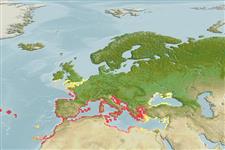Common names from other countries
Environment: milieu / climate zone / depth range / distribution range
Ecología
. Tropical; 53°N - 26°N, 32°W - 37°E
Distribución
Países | Áreas FAO | Ecosistemas | Ocurrencias, apariciones | Introducciones
Eastern Atlantic and the Mediterranean.
Length at first maturity / Tamaño / Peso / Age
Maturity: Lm ? range ? - ? cm Max length : 4.0 cm CW macho / no sexado; (Ref. 842)
Intertidal (Ref. 107021). It is found on rocks from upper to middle shore, also in crevices in breakwaters and pier piles or similar habitats (Ref. 842). Omnivore but cannot be simply considered an opportunistic feeder (Ref. 107021).
Life cycle and mating behavior
Madurez | Reproducción | Puesta | Huevos | Fecundidad | Larva
Members of the order Decapoda are mostly gonochoric. Mating behavior: Precopulatory courtship ritual is common (through olfactory and tactile cues); usually indirect sperm transfer.
Debelius, H. 2001. (Ref. 842)
IUCN Red List Status (Ref. 130435)
CITES status (Ref. 108899)
Not Evaluated
Not Evaluated
Human uses
Pesquerías: comercial
| FishSource |
Herramientas
Fuentes de Internet
Estimates based on models
Preferred temperature
(Ref.
115969): 17.6 - 19.9, mean 18.8 (based on 394 cells).
Resiliencia
Alto, población duplicada en un tiempo mínimo inferior a 15 meses (K=0.83-1.14).
Price category
Unknown.
